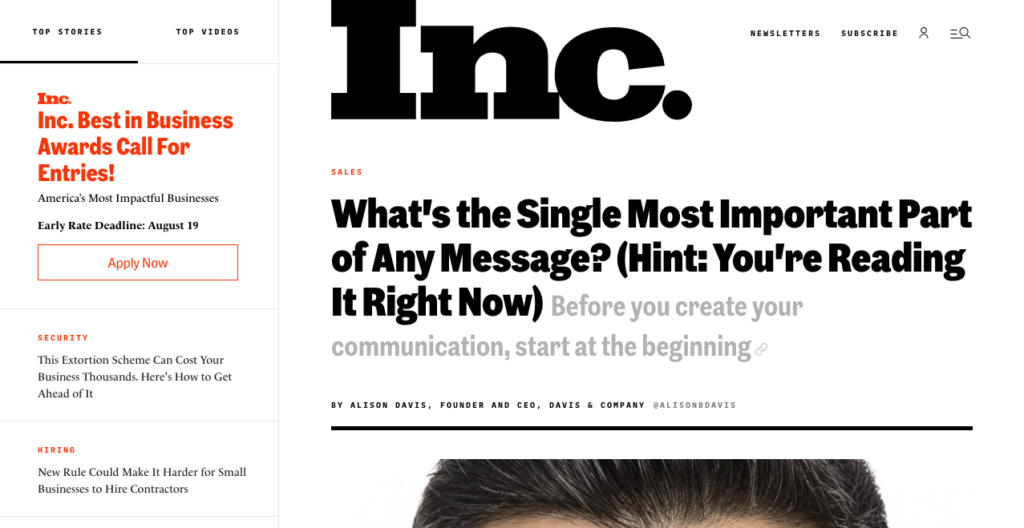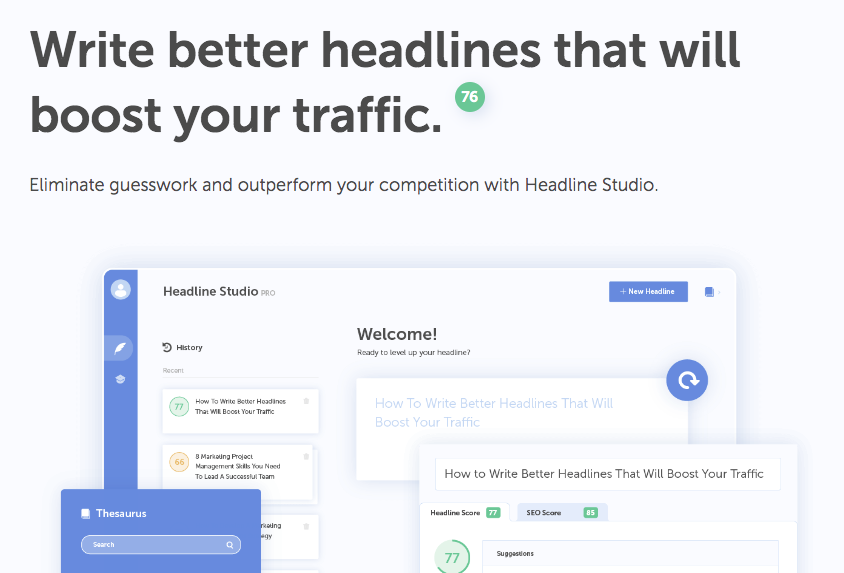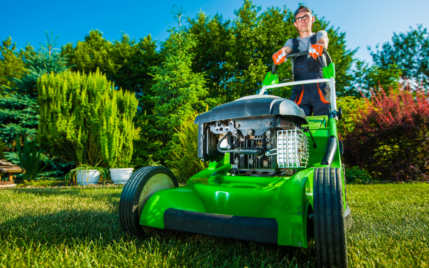How to Write Great Article Titles: Proven Tips, 7 Popular Headlines & More

When you buy something through one of the links on our site, we may earn an affiliate commission.
When someone puts a keyword into Google, the first thing they see is a bunch of article titles. Before they read your meta description or look at your domain name, they see the title of your article. More often than not, that title will either encourage them to click on your page or make them keep scrolling to find one that does.
The Internet is filled with millions of articles, vying for attention. So, how do you make your article stand out? How can you get noticed online?
Well, the actual process is a little bit more complicated than simply writing a catchy headline, but hey—it's the first step. And don't let anyone tell you that writing a single line of copy is the easy part. Writing article titles that resonate with your audience and tick all the boxes for Google is easier said than done.
Contents
Why Do Article Titles Matter?

Well, when you do it right, an article title can help increase your organic traffic and boost your on-page SEO (search engine optimization).
As the first thing your potential reader will see in the search engine results, a catchy title can pull them in to read the rest of your content. Another bonus of a good title is that it will let readers know what the rest of the article is about in just a few words.
By attracting readers with your article title, you're more likely to gain clicks and drive traffic to your site. In addition, if you show related articles at the end of your posts, good headlines can even entice readers to stay on your site and keep consuming more content.
Moreover, article titles can help increase your on-page SEO and tell Google where you should rank on SERPs. Using keywords can help search engines know how relevant your content is to a particular query. Also, more people clicking on your article will indicate that you are providing high-quality content and Google will boost your article further.
So, just like titling academic writing like a research paper or journal article, you want your blog post to have an enticing headline that grabs the reader's attention and clearly states the topic.
In fact, if you look at the anatomy of a blog post, the article title is the most important step to rank higher than your competition.
The reward? A positive cycle of better SERP ranking and more traffic. More traffic means a better ranking, a better ranking means more traffic. Win, win, winning.
7 Different Types of Article Titles

Like I said, writing the perfect article title is easier said than done. But there are some pretty standard formulas that a lot of catchy headlines use to grab your attention.
For the most part, one of these types of article titles should work for your content. They are thought-provoking, engaging, and a great way to get your blog to show up during a search.
The How To
Ever wonder why WikiHow is almost always the top result for a "how to" query? Their titles are clear, concise, and help their reader solve a problem.
Writing a "how to" headline is pretty straightforward.
Identify the problem that your content is solving, then simply work backwards from there to discover your article title.
Have a post on the best way to lay wood flooring? "How to Lay Wood Flooring Like an Absolute Pro."
In general, these headlines work best for tutorial type content.
The Question
The so-called "curiosity gap" is the space between what we know (or think we know) and what we want to know. You can leverage this in your article's title by formulating a question headline.
Invite your readers to engage with your content simply by putting a question mark at the end of your article title.
"Can Investing Young Really Mean You'll Grow Old Rich?"
The Controversial Headline
Nothing like a bit of juicy drama to get people clicking. They say all publicity is good publicity, and sometimes that's true. By creating a controversial headline you are inviting the readers that agree with you to come be part of a like-minded community.
The readers that don't agree with you? Chances are they'll be tempted to click too, either to leave their two cents in the comments or see just how crazy you are.
Think along the lines of, "Why Vegans are Ruining the World and You Should Eat More Meat", and "10 Reasons Why Men are More Likely to Cheat Than Women."
Controversial headlines are particularly great for blogs with comments sections as this type of article title almost always invites engagement.
The Problem Solver
Similar to the "how-to" style headline, problem solver titles identify a problem for your audience and promise to solve it.
This article title style is effective in hooking your readers because they immediately promise value. By clicking, people have invested in finding out an answer to their problem.
Titles like "7 Ways to Combat Stress Acne" clearly state what problem they are addressing and let the reader know what they can expect.
Short and Sweet
Inevitably, the online world is full of skim readers. Your title could be 10 words long, but chances are 50% or less of that, so about 5 words will actually get read by people skimming through looking for content.
So save yourself the hassle of coming up with longer titles and just keep it short and to the point.
You don't always need the extra word count to state exactly what your article is about. There are definitely times when a shorter title is more likely to win you a reader.
Consider the title "Squarespace vs Wix" or "Illegal Plants in California." Both are to-the-point for specific queries.
The Round-Up/List Article Title
List headlines tend to perform really well in terms of attracting more traffic. Ultimately, people are just naturally drawn to lists.
A round up of the top 10 products or ways of doing something can be an effective way to encourage readers to click on your content.
Not only do list-type headlines catch people's attention, but they are also great for your SEO. They are especially useful if you are trying to rank for a competitive keyword.
Anything like "Top 10 Reasons to Travel to Croatia" to "6 Different Ways to Brew Coffee" tick the box for a list-type headline.
"Things I Wish I'd Known"
This article title style is particularly popular with personal blogs or journey blogs. It's like your mom saving you from making mistakes by sharing her wisdom of the world with you.
"Things I Wish I'd Known Before I Started Renovating Our House" or "Things I Wish I'd Known Before Solo Traveling in Europe"... you get the idea.
This type of headline can appeal to readers if you are really clear on what the topic is and have some established topical authority.
Tips to Write a Catchy Article Title To Crush Your Competition
Headline writing seems easy enough. It's just a title, after all. Surely, the content is more important, right?
Wrong.
Great content is likely to go unread if it doesn't also have a great title.
Imagine if JRR Tolkein had named his books something other than Lord of the Rings. What if he had named the series Halfling Travels to the Mountain? Do you think millions of people still would have read it? Would it have become the global phenomenon that it grew to be?
Whether you're writing a book, a journal article, or a blog post—the aim is to get people to read it. To do that, you need to write a good title.
Here are some tricks you can use to formulate catchy headlines:
- Use emotional/power words
- Include concrete numbers and/or stats
- Use "trigger" words like what, when, why, or how
One thing you don't want to do is get into the habit of writing clickbait article titles. Clickbait titles can get readers to your site, but you won't be building a loyal following, and you can hurt your online reputation (but it is worth checking out these clickbait title generators).
It's also important that you consider the SEO impact your article titles can have. Two important factors to keep in mind are:
- Optimize your word count
- Put your keyword at the beginning
Also, don't be afraid to try a few different headlines before deciding on your final title!
Use Emotional/Power Words

Certain words resonate with readers more powerfully than others. Often, using emotional words can be a way to hook your reader in.
Consider using words like:
| immediately | popular | exclusive |
| rare | suddenly | better |
| now | luxury | breakthrough |
| unlock | revolutionary | easy |
| introducing | miracle | successful |
| practical | proven | challenge |
| useful | simple | quick |
| insider | helpful | love |
| magic | lifetime | expert |
| latest | opportunities | ultimate |
These power words can appeal to people's emotional response and encourage them to become invested in your content.
Include Concrete Numbers and/or Stats
Numbers are an easy way to make your headline stand out. A lot of the time as people are skimming through they don't actually take the time to read all the words. For that reason, numerals can catch the eye when words don't.
You can also take advantage of people's natural curiosity and draw them in with concrete stats. In general, people will equate numbers with facts. Using numbers in your headline can serve to signal a clear answer for readers on their topic of interest.
Finally, including a number in your headline can help with expectation management.
The What, When, Why, or How Article Title
While numbers are great, they don't work for every kind of blog post title. When using a number in your title doesn't sound right, try to use trigger words instead.
What, when, why, and how are all great words to use in your title to catch people's attention and trigger a response.
These words help to identify and solve a question for the reader while laying out what information your content can provide.
You want your article headline to be fluid and digestible, so don't force something that doesn't work. Numbers are good for making your content takeaways stand out, but trigger words can be just as effective in contributing to a catchy headline.
For example, a title like, "3 Ways to Grow Houseplants" is vague and actually not a very clear indicator of what your content is about. You're throwing numbers in for the sake of it. So what do you do if your content just doesn't invite a numerical headline?
Try something like, "How to Grow Free Plants! When and Why to Propagate Your Houseplants." You can deliver your key message clearly and let people know what they can expect from your content.
Optimize Word Count
There are a few reasons why optimizing your word count can be the difference between a good headline and a great one.
For one, we all know people have the attention span of a goldfish, and it's only getting shorter. You want to keep things short and sweet. Don't lose your audience in a sea of unnecessary words. But at the same time, if your article's title is too short, then you risk not giving away enough information to capture your reader.
You've really got to aim for that sweet spot when it comes to your title length.
Also, while your title tag is technically different from your actual heading, this will be what shows up on SERPs, and Google will only show the first 50-60 characters, so make them count.
If you want your content to perform well in organic searches, than title tags and meta descriptions should be your primary focus.
For social media and email marketing campaigns, you can tweak your headline to best suit the platform it will appear on.

Improve Your Headlines Easily
Headline Studio by CoSchedule is one of my favorite tools for writing the perfect blog post title. Helping you get your word count just right is just one of the many features the free version offers. Plus, if you're using WordPress they have a free plug-in to make things really easy.
Put Your Keyword At the Beginning
One of the most important things you can do to ensure your article performs well in an organic search is to prioritize the first few characters of your headline or title tag. Search engine results pages will often show the first 50-60 characters.
To make the most of limited character space, put your keyword at the beginning of your title. Not only does this signal to your audience right away what you're covering, it can help boost your SERP rank.
Great Article Titles, More Readers, More Traffic!
Content is king, but only with a good headline. A bad article title can let you down in so many ways.
When in doubt, remember that the key to winning readers is clarity and honesty. Be clear about what your content includes and then deliver on that promise. It's easy to overcomplicate things worrying about things like SEO and SERPs but simplicity is often key.
Use Tools to Help
If you're still struggling with crafting the perfect article title, check out these 15 blog post title generators that do the heavy lifting for you!
All in all, catchy titles are an important part of getting your content seen by more people. Far from being an afterthought to a great blog post, the headline should be one of the first things you brainstorm when coming up with a new post. That way, you can tailor your content to make sure you stay true to your title.
Try using some of these tips and formulas to write your next headline and see if you get a bump in traffic!
Want to learn step-by-step how I built my Niche Site Empire up to a full-time income?
Yes! I Love to Learn
Learn How I Built My Niche Site Empire to a Full-time Income
- How to Pick the Right Keywords at the START, and avoid the losers
- How to Scale and Outsource 90% of the Work, Allowing Your Empire to GROW Without You
- How to Build a Site That Gets REAL TRAFFIC FROM GOOGLE (every. single. day.)
- Subscribe to the Niche Pursuits Newsletter delivered with value 3X per week
My top recommendations
















